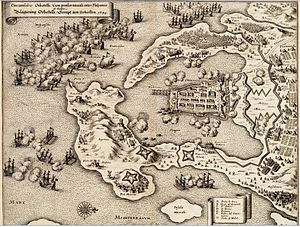Battle of Orbetello
| Battle of Orbetello | |||||||
|---|---|---|---|---|---|---|---|
| Part of the Thirty Years' War and the Franco-Spanish War (1635) |
|||||||
 The blockade of Orbetello, engraving by Matthäus Merian. |
|||||||
|
|||||||
| Belligerents | |||||||
|
|
|
||||||
| Commanders and leaders | |||||||
| Marquis of Brézé † | Count of Linhares | ||||||
| Strength | |||||||
| 24 sailing ships 20 galleys 8 fireships 4 fluyts |
22 sailing ships 30 galleys 5 fireships |
||||||
| Casualties and losses | |||||||
| 1 fireship exploded | 1 frigate scuttled | ||||||
The Battle of Orbetello, also known as the Battle of Isola del Giglio, was a major naval engagement of the Franco-Spanish War of 1635. It was fought on 14 June 1646 off the Spanish-ruled town of Orbetello, on the coast of Tuscany, Italy, between a French fleet led by Admiral Armand de Maillé, Marquis of Brézé, and a Spanish fleet commanded by Miguel de Noronha, 4th Count of Linhares sent to break the blockade of Orbetello and relieve the town, besieged since 12 May by a French army under the command of Prince Thomas of Savoy. The Battle of Orbetello was tactically very unusual, since it was fought by sailing ships towed by galleys in a light breeze.
After a hard but inconclusive fight during which Admiral Brézé was killed, the French fleet withdrew to Toulon leaving the sea to the Spanish, who decided not to pursue them to relieve Orbetello. The land forces disembarked by Count of Linhares a few days later, however, failed to dislodge the French lines, and the siege could be undertaken until 24 July, when another Spanish army led by the Marquis of Torrecuso and the Duke of Arcos, which had come from the Kingdom of Naples across the Papal States, defeated the besieging French troops, forcing them to retreat with heavy losses.
In 1646, after several naval successes against Spain along the Mediterranean, Cardinal Mazarin planned a naval expedition to conquer the Spanish-held State of Presidi with the aim of interrupting Spanish communications with the Kingdom of Naples, threatening the initial stage of the Spanish military corridor, the so-called Spanish Road, and also to frighten pope Innocent X, whose Spanish sympathies displeased him. For this purpose, a fleet commanded by young Admiral Marquis of Brézé was assembled at Toulon. Made of 36 galleons, 20 galleys and a large complement of minor vessels, it had on board an army of some 8,000 infantry and 800 cavalry with baggage under the command of Thomas Francis of Savoy, who had previously been at the employ of the Spanish Crown.
...
Wikipedia
